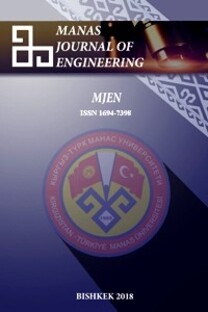Detection of some antioxidant enzyme activities in apricot fruit grown in Van region from Turkey
Detection of some antioxidant enzyme activities in apricot fruit grown in Van region from Turkey
___
- [1] Tosun İ., Yüksel S., “Üzümsü meyvelerin antioksidan kapasitesi”, Gıda, 28(3), (2003), 305-311
- [2] Akkuş İ., “Serbest Radikaller ve Fizyopatolojik Etkileri”, Mimoza Yayınları, Konya, 1995, 68
- [3] Yılmaz İ., “Antioksidan içeren bazı gıdalar ve oksidatif stress”, İnönü Üniversitesi Tıp Fakültesi Dergisi, 17(2), (2010), 143-153
- [4] Derviş E., “Oral antioksidanlar. Dermatoz”, 2(1), (2011), 263-267
- [5] Güler E., Dedeakayoğulları H., Kılınç A., Yalçın A.S., “Oksidatif stresin belirlenmesinde yeni bir yaklaşım”, 23.ulusal biyokimya kongresi, 2011
- [6] Mavi A., “İnsan eritrosit ve lökositlerinden süperoksit dismutaz enzimininsaflaştırılması ve bazı ilaçların enzim üzerine etkilerinin incelenmesi”, Ph.D. dissertation, Institute of Natural Sciences, Atatürk University, 2005.
- [7] Becker A., “Controlling als Praxis: Eine structurationsTheoretische Perspektive auf Controlling”, In E. Scherm & G. Pietsch (Hrsg.), Controlling: Theorien und Konzeptionen. 2004, pp. 753-777
- [8] T.C Orman ve Su İşleri Bakanlığ Orman Genel Müdürlüğü Yayınları Maviyemiş Likapa Eylem Planı 2015-2019
- [9] Uruk T., Kahraman S., “Yaban Mersini (Vaccinim myrtillus) Antioksidan aktivitesinin araştırılması”, Iğdır.Üniversitesi Fen Bilimleri Enst.Der., 71(4), (2017), 77-83
- [10] Mot C.A., Dumitrescu S.R., Sarbu C.,.“Rapid and effective evaluation of the antioxidant capacity of propolis extracts using DPPH bleaching kinetic profiles, FT-IR and UV-VIS spectroscopic data”, Journal of Food Composite and Analysis, 24, (2011), 516-522
- [11] Hayyan M., Hashim M.A., Al Nashef I.M., “Superoxide Ion, Generation and Chemical Implications”, Chem. Rev., 116 (5), (2016), 3029– 3085.
- [12] Brewer G.J., “Achromatic regions of tetrazolium stained starch gels: inherited electrophoretic variation”, American Journal of Human Genetics., 19 (5), (Sep 1967), 674–80.
- [13] Therond P., Bonnefont-Rousselot D., Davit-Spraul A., Conti M., Leqrand A., “Biomarkers of oxidative stress: an analytical approach”, Curr Opin Clin Nutr Metab Care, 3, (2000), 373-84
- [14] Sargowo, D., Ovianti, N., Susilowati, E., Ubaidillah, N., Nugraha, A. W., Proboretno, K. S., Failasufi M., Ramadhan F., Wulandari H., Waranugrah Y., Putri, D. H. “The role of polysaccharide peptide of Ganoderma lucidum as a potent antioxidant against atherosclerosis in high risk and stable angina patients”, Indian heart journal, 70(5), (2018), 608-614
- [15] Erçin U., Bilgihan A., Erkan A.F., Yücel, H.б “New Parameters of Coronary Artery Diseases: Oxidative Stress Markers”, Journal of Turkish Clinical Biochemistry, 17(1), (2019), 48-55
- [16] Sun. Y., Oberley LW., Li Y., “A simple method for clinical assay of superoxide dismutase”, Clin Chem. Mar, 34(3), (1988), 497-500
- [17] Gutteridge J.M., “Lipid peroxidation and antioxidants as biomarkers of tissue damage”, Clin Chem. Dec;41(12 Pt 2), (1995), 1819-28.
- [18] Bergmeyer J., Grabl M., “Methods of Enzymatic Analysis (Third Edition), Germany, 1983, 190-302
- [19] Stadtman E.R., “Importance of individuality in oxidative stress and aging”, FreeRadical Biology and Medicine, 33, (2002), 597-604
- [20] Çaylak E, “Hayvan ve bitkilerde oksidatif stres ile antioksidanlar. Biyokimya”, AD, Çankırı Karatekin Üniversitesi 18200 Tıp Araştırmaları Dergisi, 9(1) , (2011), 73-83
- [21] Gutteridge J.M.C.,“Lipid peroxidation and antioxidants as biomarkers of tissue damage”, Clin. Chem., 41, (1995), 1819-1828
- [22] Rice-Evans C., , Re R, Pellegrini N., Proteggente A., Pannala A., Yang M., “Antioxidant activity applying an improved ABTS radical cation decolorization assay”, Free Radic. Biol. Med., 26, (1999), 1231-1237
- [23] Skrovankova S., Sumezynki P., Mlcek J., Jurikova T., Sochor J., “Bioactive Compounds and Antioxidant Activity in Different Types of Berries”, Int.J.Mol.Sci.16, (2015), 24673-24706
- [24] Haznedaroğlu M.Z., Öztürk T. Konyalıoğlu S., “Salvia smyrnaea boiss. uçucu yağının antioksidan ve antimikrobiyal aktivitesi”, Bitkisel İlaç Hammaddeleri Toplantısı, Bildiriler, 2002. Eskişehir.
- [25] Tosun İ., Üstün Ş., “An investigation about antioxidant capacity of fruit nectars”, Pakistan Journal of Nutrition, 2(3), (2003), 167-169
- ISSN: 1694-7398
- Yayın Aralığı: 2
- Başlangıç: 2001
- Yayıncı: KIRGIZİSTAN-TÜRKİYE MANAS ÜNİVERSİTESİ
Ali Tahir KARAŞAHİN, Abdullah Erdal TÜMER
Nevroz Aslan ERTAS, Arif KIVRAK
Modelıng Occupatıonal Health And Safety Rısks Among Unskılled Workers In Constructıon Industry
Hezekiah Oluwole ADEYEMİ, Olatilewa Rapheal ABOLADE, Ajibola Oluwafemi OYEDEJI, Olanrewaju Bilikis OLATUNDE
Omowumi G. OLASUNKANMI, Ajibola O. OYEDEJI, Ayodeji A. OKUBANJO
Hilal Demir KIVRAK, Aykut ÇAĞLAR, Tulin Avcı HANSU, Ömer ŞAHİN
Analysis of Turkish 6/49 lottery results
Alper Vahaplar, Murat Erşen Berberler
A new approach on the stability of fractional singular systems with time-varying delay
Omowumi G. Olasunkanmı, Ajibola O. Oyedejı, Ayodeji A. Okubanjo
